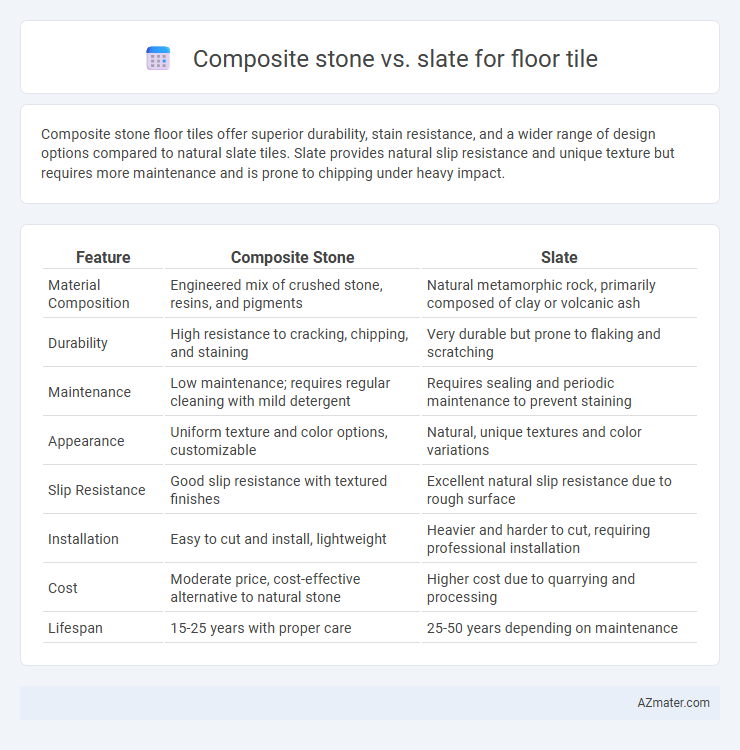Composite stone floor tiles offer superior durability, stain resistance, and a wider range of design options compared to natural slate tiles. Slate provides natural slip resistance and unique texture but requires more maintenance and is prone to chipping under heavy impact.
Table of Comparison
| Feature | Composite Stone | Slate |
|---|---|---|
| Material Composition | Engineered mix of crushed stone, resins, and pigments | Natural metamorphic rock, primarily composed of clay or volcanic ash |
| Durability | High resistance to cracking, chipping, and staining | Very durable but prone to flaking and scratching |
| Maintenance | Low maintenance; requires regular cleaning with mild detergent | Requires sealing and periodic maintenance to prevent staining |
| Appearance | Uniform texture and color options, customizable | Natural, unique textures and color variations |
| Slip Resistance | Good slip resistance with textured finishes | Excellent natural slip resistance due to rough surface |
| Installation | Easy to cut and install, lightweight | Heavier and harder to cut, requiring professional installation |
| Cost | Moderate price, cost-effective alternative to natural stone | Higher cost due to quarrying and processing |
| Lifespan | 15-25 years with proper care | 25-50 years depending on maintenance |
Introduction to Composite Stone and Slate Tiles
Composite stone floor tiles combine natural stone fragments with resin binders, offering enhanced durability and a uniform surface ideal for high-traffic areas. Slate tiles, formed from metamorphic rock, provide a naturally textured, slip-resistant surface with unique color variations and durability suited for both indoor and outdoor flooring. Choosing between composite stone and slate depends on factors like aesthetic preference, maintenance requirements, and environmental exposure.
Material Composition: Composite Stone vs Slate
Composite stone floor tiles consist of engineered materials combining crushed natural stones with resins and binders, resulting in a durable, uniform surface resistant to stains and scratches. Slate floor tiles are natural metamorphic rock composed mainly of quartz, mica, and chlorite, offering unique texture and color variations but requiring more maintenance due to porosity. The engineered composition of composite stone provides enhanced durability and design consistency compared to the natural, variable properties of slate.
Aesthetic Differences: Look and Feel
Composite stone floor tiles offer a uniform appearance with smooth, consistent textures and a wide range of color options, creating a modern and polished look. Slate tiles display natural, rugged textures with unique color variations and veining patterns, providing an earthy, rustic aesthetic. The tactile experience differs as composite stone feels cooler and smoother underfoot while slate provides a slightly rougher, more organic surface.
Durability and Longevity Comparison
Composite stone flooring offers enhanced durability due to its engineered composition, resisting scratches, stains, and heavy foot traffic better than natural slate. Slate, known for its natural cleft texture, provides excellent longevity with proper sealing but can be more susceptible to chipping and moisture damage over time. The choice between composite stone and slate hinges on maintenance preferences and the balance between rugged durability and authentic natural aesthetics.
Installation Process: Methods and Ease
Composite stone floor tiles offer a faster installation process due to their uniform size, lightweight nature, and compatibility with standard adhesive methods, reducing labor time significantly. Slate tiles require more precise handling and skilled labor because of their natural irregularities, varying thickness, and need for specialized cutting tools to ensure a level surface during installation. The ease of installing composite stone makes it ideal for DIY projects, while slate's complex installation provides durability and unique aesthetics favored by professional installers.
Maintenance Requirements and Cleaning Tips
Composite stone floor tiles require minimal maintenance, needing only regular sweeping and occasional mopping with mild detergent to prevent dirt buildup. Slate tiles demand more care due to their porous nature, necessitating periodic sealing to protect against stains and moisture. For both materials, avoiding harsh chemicals preserves surface integrity and prolongs tile lifespan.
Cost Analysis: Initial Investment and Long-Term Value
Composite stone floor tiles generally offer a lower initial investment compared to natural slate, with prices ranging from $3 to $8 per square foot, while slate can cost $5 to $15 per square foot due to its natural material and more intricate installation requirements. Over the long term, composite stone provides durable, low-maintenance performance and resists staining and chipping, which reduces repair and replacement costs. Slate, although more expensive upfront, offers exceptional longevity, unique aesthetics, and can add greater property value, but it may require periodic sealing and specialized maintenance, impacting overall cost-effectiveness.
Slip Resistance and Safety Considerations
Composite stone floor tiles offer superior slip resistance due to their engineered textured surfaces and non-porous composition, making them ideal for high-traffic areas prone to moisture. Slate tiles, while naturally slip-resistant because of their rough, uneven texture, can become slippery when polished or wet, requiring additional anti-slip treatments for safety. Safety considerations emphasize composite stone's consistent performance in wet environments, whereas slate demands regular maintenance to preserve its slip resistance and prevent accidents.
Environmental Impact and Sustainability
Composite stone flooring offers a more sustainable option compared to slate, as it often incorporates recycled materials and requires less intensive quarrying processes, reducing habitat disruption. Slate extraction involves significant environmental degradation due to mining, contributing to landscape alteration and waste generation. Choosing composite stone tiles supports eco-friendly practices by minimizing carbon footprint and resource depletion while maintaining durability and aesthetic appeal.
Best Applications: Where Each Tile Excels
Composite stone flooring excels in high-traffic commercial spaces and residential kitchens due to its durability, low maintenance, and resistance to stains and scratches. Slate tiles are ideal for outdoor patios, bathrooms, and rustic interiors because of their natural slip resistance, unique texture, and heat retention properties. Both materials offer distinct advantages: composite stone provides uniformity and modern aesthetics, while slate delivers organic beauty and enhanced traction.

Infographic: Composite stone vs Slate for Floor Tile
 azmater.com
azmater.com